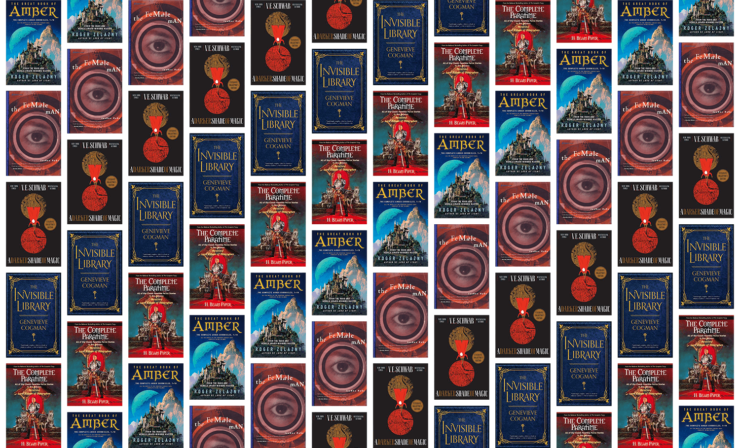Travel between parallel universes (or time lines, as they’re sometimes called) goes back a long way in SF, but has become vastly more popular since the 1950s and the Many-Worlds interpretation of quantum mechanics, whereby the outcome of every quantum-scale event is resolved by creating new parallel versions of the entire universe for each possible outcome.
This has been on my mind lately, as I’ve just finished the ninth novel in my own parallel-universe hopping Merchant Princes saga. It began in The Family Trade as a normal-at-first-glance portal fantasy. In portal fantasy, a protagonist from our own world travels to a secondary world where things are different, and frequently returns, but it’s usually a strict back-and-forth. Think of the Chronicles of Narnia by C. S. Lewis or The Windrose Chronicles by Barbara Hambly. But three books into the series it turned a corner into SF, and nine books in, Invisible Sun ends with a space battle and raises the curtain to reveal an infinitely larger vista, a war fought on as large a scale as any space operatic clash of galactic empires.
Where does the enduring attraction of parallel universe travel come from, and how does it differ from portal fantasy (or alternate history, for that matter)?
In SF, travel to parallel universes is a convenient work-around for the show-stopping difficulty of rationalizing travel to other worlds in our own continuum. You don’t need an FTL drive or a starship to visit the universe next door! Moreover, when travelling to another version of Earth you’re almost guaranteed a habitable biosphere. So you get to play with a whole new world without the worldbuilding that goes into exoplanetography or FTL drives. You can also leverage parallel history: what if you find yourself on the version of Earth where the Russian Revolution fizzled, or France invaded and occupied England in 1756 and the industrial revolution was delayed by a century?
Parallel universes are also popular in Fantasy, albeit for a different reason: it provides an excuse to change the laws of nature (and magic). Magic becomes indistinguishable from technology if you make it too rigorous, but adding parallel worlds to fantasy lets you can shake up the underlying logic of a setting. It’s also a fine excuse for a different variety of travelogue from the usual. There’s no need for the minutiae of sailing ships, horses, or carriages if you’re travelling to the dimension of airships and steam engines (or dragons, for that matter).
Here are five decent examples of the trope, written in both fantasy and SF style:
The Chronicles of Amber by Roger Zelazny
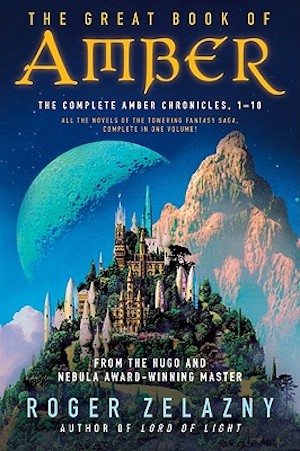
Beginning with Nine Princes in Amber (published in 1970), Zelazny’s ten book series puts the fun into dysfunctional families. Corwin of Amber, our initially-amnesic protagonist, is one of the ten bickering children of the king of Amber, the ur-kingdom that casts endless shadows—by which I mean other worlds—upon the abyss of Chaos. The family have inherited paranormal powers—the ability to walk through shadows to any world they can imagine, uncanny healing, remarkable longevity—but what they don’t possess is amity: their backbiting and feuding can be lethal. The godlike King Oberon is missing, the fate of the universe is in jeopardy, and…they’re the type specimen for parallel universe travel in fantasy. These are short books, written with Zelazny’s characteristic elan and playfulness, and published between 1970 and 1991: and while they’re very much of their time (30-50 years ago) they haven’t aged as poorly as many other works from the same period.
The Invisible Library series by Genevieve Cogman
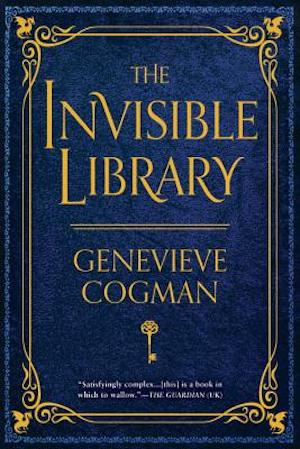
Genevieve Cogman’s Invisible Library series (starting with the titular The Invisible Library, first published in the UK in 2014) mirrors The Chronicles of Amber’s setting while using it for drastically different ends. There is Chaos (characterized by the malign and capricious Fae) and there is Order (oppressively maintained by Dragons), and the worlds between total chaos and total order exist in a spectrum of states. Holding itself apart from the endless cold war between the fae and the dragons is the Library, which exists outside of space and time: a liminal space curated by the Librarians, who harvest unique-throughout-the-multiverse works of fiction. Our protagonist Irene is a sensible lady in sensible shoes—the better for running with whatever book she has acquired (read: stolen) for the Library. She is assigned to a branch office in an unstable, chaos-adjacent steampunk London (there are airships, famous detectives, werewolves, and clockwork crocodiles), where it gradually becomes apparent that a struggle for control of the multiverse is under way and the Library is in danger of being sucked in. Great fun, and an example of the form updated for the present.
The Paratime series by H. Beam Piper
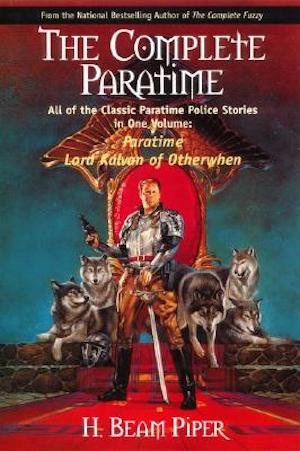
Writing between 1948 and his death in 1965, H. Beam Piper created a series of short stories and one novella dealing with the colonial expansion of a technologically advanced civilization, the people of Home Timeline, who secretly exploit the inhabitants (both high and low tech) of the other time lines they visit by means of their conveyors. Their own world is resource-depleted, so of course they use their access to paratime to extract wealth and materials from the unknowing neighbors, while policing paratime to keep its existence secret from the residents of other time lines. They’ve been published as standalone short stories and one novel (Lord Kalvan of Otherwhen) assembled from extra-short 1960s novels: also collected in an omnibus edition, The Complete Paratime (2001).
There is, to modern sensibilities, a ruthlessly colonial edge to this setup: if there are any mitigating circumstances at all, they lie in the secret paratime empire being headquartered in east Asia rather than being a re-siting of the British Empire (which Piper clearly had in mind for some of their political mechanisms).
(I’ve cited both the Chronicles of Amber and the Paratime stories as taproots for my own Merchant Princes universe: as in the former, the ability to travel between timelines is hereditary, and as in the latter, imperialist exploitation ensues. I consider Piper’s Paratime significant as one of the earliest examples of parallel universe travel in modern American SF—this doesn’t mean it’s unproblematic.)
A Darker Shade of Magic by V. E. Schwab
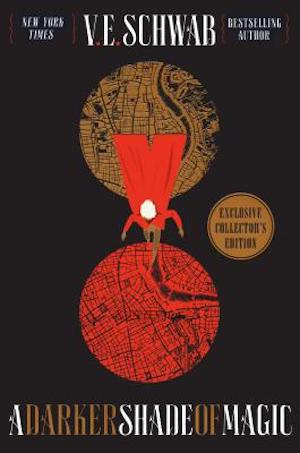
V. E. Schwab’s Shades of Magic trilogy, beginning with A Darker Shade of Magic, is another fantastical take on trade between parallel universes, although it’s a heavily restricted trade: the Antari are rare (very rare) magicians with the ability to visit other versions of London—Red, Grey, White, and the now-forbidden Black versions. (Grey London, almost bereft of magic, is ruled over by George III.) Kell, Antari to the king of Red London, serves as an ambassador to the royals of White and Grey London. While visiting Grey London he falls foul of a one-eyed pickpocket, who forces him to give her a ride to another world. Beyond which point anything I say would be a spoiler: suffice to say, it’s character-driven adventure, beautifully executed, and a fine illustration of the change-the-rules-of-magic use of parallel universes in fantasy.
The Female Man by Joanna Russ
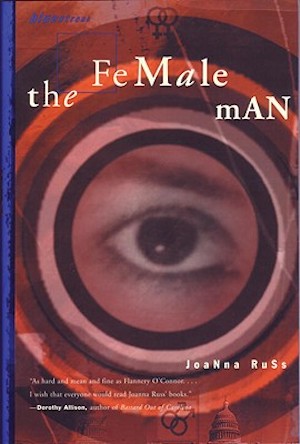
As angry and effective a landmark of feminist SF when it was published in 1975 as it would have been when it was written in 1970, The Female Man gives us four parallel universes, in which overlapping versions of protagonists (Joanna/Jeannine/Janet/Jael) exist—they visit one another, comparisons of their prescribed gender roles and socialization are made, and identities are examined. It’s widely considered one of the wellsprings of feminist SF, rather than parallel universe travel, but I include it here to demonstrate that parallel universe travel isn’t simply an excuse for a travelogue: it can be used effectively to contrast alternative outcomes.
(Trigger warning: the Jael sections have been criticized as transphobic—not unusual in works associated with second-wave feminism. Russ subsequently apologized. As with Paratime and Amber, The Female Man reflects the time and culture in which it was written. Attitudes in the relatively recent past may be distasteful or disturbing to readers.)
Honorable mentions:
There are too many parallel universe sagas out there to list them all. But I feel that I ought at least to mention some of the more prominent ones that nevertheless didn’t support my tub-thumping agenda here, notably: The Lathe of Heaven by Ursula K. Le Guin, The Fall of Ile-Rien by Martha Wells, The Long Earth by Stephen Baxter and Terry Pratchett, the Millennium’s Rule series by Trudi Canavan, the Wayward Children series by Seanan McGuire, Eternity and Eon by Greg Bear.
Buy the Book
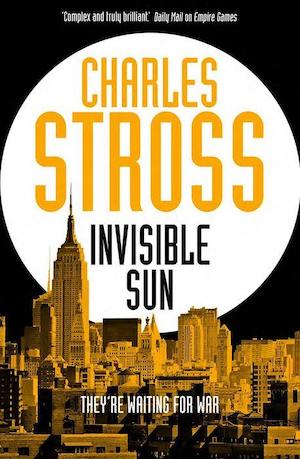

Invisible Sun
Charles Stross lives in Edinburgh, Scotland, and to date has three Hugo Awards and been nominated twelve times. He has also won the Locus Award for Best Novel, the Locus Award for Best Novella, and has been shortlisted for the Arthur C. Clarke and Nebula Awards. Stross is the author of the bestselling Merchant Princes series, the Laundry series, and several stand-alone novels including Glasshouse, Accelerando, and Saturn’s Children.










